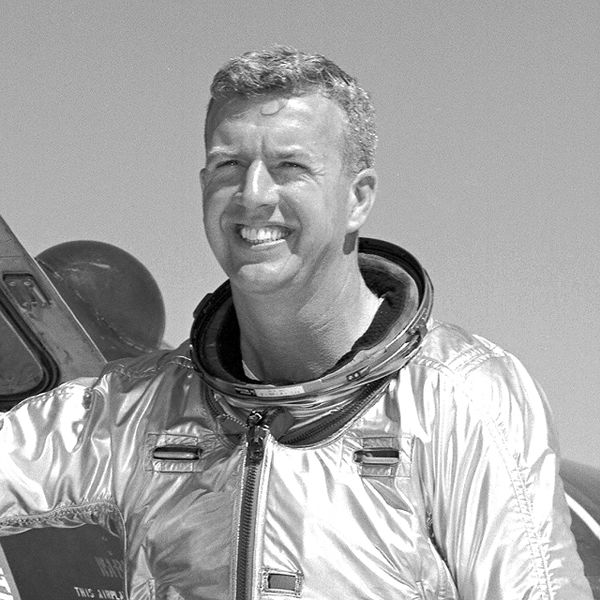
Tamanho desta previsualização: 600 × 600 pixels. Outras resoluções: 240 × 240 pixels | 480 × 480 pixels | 640 × 640 pixels.
Imagem numa resolução maior (640 × 640 pixels, tamanho: 285 kB, tipo MIME: image/jpeg)
Este arquivo é do Wikimedia Commons e pode ser utilizado por outros projetos. Sua página de descrição de arquivo é reproduzida abaixo.
Descrição do arquivo
| DescriçãoJoseph Albert Walker.jpg |
English: Joseph Albert "Joe" Walker is seen here after a flight in front of the X-15 #2 (56-6671) rocket-powered research aircraft. Joseph A. Walker was a Chief Research Pilot at the NASA Dryden Flight Research Center during the mid-1960s. |
| Data | Tirada em 30 de março de 1961 |
| Fonte | http://www.dfrc.nasa.gov/Gallery/Photo/X-15/HTML/E-6682.html |
| Autor | NASA |
| Outras versões | File:Joseph A. Walker.png |
Licenciamento
| Public domainPublic domainfalsefalse |
| Esta obra encontra-se no domínio público porque foi criada pela NASA. A política de direitos autorais da NASA diz que "o material da NASA não é protegido por direitos autorais a não ser quando especificado". (página sobre direitos autorais da NASA ou Política de uso de imagens da JPL). |  | |
 |
Avisos:
|
| Annotations InfoField | This image is annotated: View the annotations at Commons |
Legendas
Adicione uma explicação em uma linha sobre o que este arquivo representa
Itens retratados neste arquivo
retrata
Histórico do arquivo
Clique em uma data/horário para ver como o arquivo estava em um dado momento.
| Data e horário | Miniatura | Dimensões | Usuário | Comentário | |
|---|---|---|---|---|---|
| atual | 20h01min de 18 de setembro de 2015 |  | 640 × 640 (285 kB) | wikimediacommons>Mirecki | User created page with UploadWizard |
Uso do arquivo
Não há páginas que usem este arquivo.
Metadados
Este ficheiro contém informação adicional, provavelmente adicionada a partir da câmara digital ou scanner utilizada para criar ou digitalizar a imagem. Caso o ficheiro tenha sido modificado a partir do seu estado original, alguns detalhes poderão não refletir completamente as mudanças efetuadas.
| Comentário de arquivo JPEG | Joe Walker is seen here after a flight in front of the X-15 #2 (56-6671) rocket-powered research aircraft. <p>Joseph A. Walker was a Chief Research Pilot at the NASA Dryden Flight Research Center during the mid-1960s. He joined NACA in March 1945, and served as project pilot at the Edwards flight research facility on such pioneering research projects as the D-558-1, D-558-2, X-1, X-3, X-4, X-5, and the X-15. He also flew programs involving the F-100, F-101, F-102, F-104, and the B-47. <p>Walker made the first NASA X-15 flight on March 25, 1960. He flew the research aircraft 24 times and achieved its highest altitude. He attained a speed of 4,104 mph (Mach 5.92) during a flight on June 27, 1962, and reached an altitude of 354,200 feet (67.08 miles) on August 22, 1963 (his last X-15 flight). This was one of three flights by Walker that achieved altitudes over 50 miles. Walker was killed on June 8, 1966, when his F-104 collided with the XB-70. The X-15 was a rocket-powered aircraft 50 ft long with a wingspan of 22 ft. It was a missile-shaped vehicle with an unusual wedge-shaped vertical tail, thin stubby wings, and unique fairings that extended along the side of the fuselage. The X-15 weighed about 14,000 lb empty and approximately 34,000 lb at launch. The XLR-99 rocket engine, manufactured by Thiokol Chemical Corp., was pilot controlled and was capable of developing 57,000 lb of rated thrust (actual thrust reportedly climbed to 60,000 lb). North American Aviation built three X-15 aircraft for the program.<p>The X-15 research aircraft was developed to provide in-flight information and data on aerodynamics, structures, flight controls, and the physiological aspects of high-speed, high-altitude flight. A follow-on program used the aircraft as a testbed to carry various scientific experiments beyond the Earth's atmosphere on a repeated basis. <p>For flight in the dense air of the usable atmosphere, the X-15 used conventional aerodynamic controls such as rudder surfaces on the vertical stabilizers to control yaw and canted horizontal surfaces on the tail to control pitch when moving in synchronization or roll when moved differentially. <p>For flight in the thin air outside of the appreciable Earth's atmosphere, the X-15 used a reaction control system. Hydrogen peroxide thrust rockets located on the nose of the aircraft provided pitch and yaw control. Those on the wings provided roll control.<p>Because of the large fuel consumption, the X-15 was air launched from a B-52 aircraft at 45,000 ft and a speed of about 500 mph. Depending on the mission, the rocket engine provided thrust for the first 80 to 120 sec of flight. The remainder of the normal 10 to 11 min. flight was powerless and ended with a 200-mph glide landing.<p>Generally, one of two types of X-15 flight profiles was used: a high-altitude flight plan that called for the pilot to maintain a steep rate of climb, or a speed profile that called for the pilot to push over and maintain a level altitude. <p>The X-15 was flown over a period of nearly 10 years--June 1959 to Oct. 1968--and set the world's unofficial speed and altitude records of 4,520 mph (Mach 6.7) and 354,200 ft (over 67 mi) in a program to investigate all aspects of piloted hypersonic flight. Information gained from the highly successful X-15 program contributed to the development of the Mercury, Gemini, and Apollo manned spaceflight programs, and also the Space Shuttle program.<p>The X-15s made a total of 199 flights and were manufactured by North American Aviation. <p>X-15-1, serial number 56-6670, is now located at the National Air and Space Museum, Washington DC.<p>North American X-15A-2, serial number 56-6671, is at the United States Air Force Museum, Wright-Patterson AFB, Ohio. The X-15-3, serial number 56-6672, crashed on 15 November 1967, resulting in the death of Maj. Michael J. Adams. |
|---|




 " class="attachment-atbs-s-4_3 size-atbs-s-4_3 wp-post-image" alt="O que estudar para o enem 2023">
" class="attachment-atbs-s-4_3 size-atbs-s-4_3 wp-post-image" alt="O que estudar para o enem 2023"> " class="attachment-atbs-s-4_3 size-atbs-s-4_3 wp-post-image" alt="Qual melhor curso para fazer em 2023">
" class="attachment-atbs-s-4_3 size-atbs-s-4_3 wp-post-image" alt="Qual melhor curso para fazer em 2023"> " class="attachment-atbs-s-4_3 size-atbs-s-4_3 wp-post-image" alt="Enem: Conteúdos E Aulas On-Line São Opção Para Os Estudantes">
" class="attachment-atbs-s-4_3 size-atbs-s-4_3 wp-post-image" alt="Enem: Conteúdos E Aulas On-Line São Opção Para Os Estudantes"> " class="attachment-atbs-s-4_3 size-atbs-s-4_3 wp-post-image" alt="Como Fazer Uma Carta De Apresentação">
" class="attachment-atbs-s-4_3 size-atbs-s-4_3 wp-post-image" alt="Como Fazer Uma Carta De Apresentação"> " class="attachment-atbs-s-4_3 size-atbs-s-4_3 wp-post-image" alt="Como Escrever Uma Boa Redação">
" class="attachment-atbs-s-4_3 size-atbs-s-4_3 wp-post-image" alt="Como Escrever Uma Boa Redação"> " class="attachment-atbs-s-4_3 size-atbs-s-4_3 wp-post-image" alt="Concurso INSS edital 2022 publicado">
" class="attachment-atbs-s-4_3 size-atbs-s-4_3 wp-post-image" alt="Concurso INSS edital 2022 publicado">


